PERENNIALS > LUPIN
Chris is a gardening writer and nature enthusiast. He graduated from Oxford Brookes University in 2022 with an MA in Psychology. Chris works with the Leeds Green Action Society, helping their food cooperative by growing various fruit and vegetables on their two allotments in Hyde Park, Leeds.
Reviewed By DAN ORI

Dan has over 27 years’ under his belt caring for plants and gardens. Working as a Horticultural Instructor and Consultant, he draws on a diverse range of experience that includes working as a Head Gardener, Tree Surgeon, Garden Centre Trouble Shooter, and writer of academic papers. Dan has a Level 3 Diploma in Horticulture and is currently a candidate for the RHS’s most prestigious award – The Master of Horticulture.
IN THIS GUIDE
LUPIN GUIDES
Say hello to what may be one of the most easily recognisable plants in the UK.
Lupins are traditional, timeless classics that have been a firm favourite among British gardeners for over a century.
These striking, stately plants, characterised by their towering spires, come in every imaginable colour – as well as a range of sizes – making them a real statement in any garden.
Overview
| Botanical Name | Lupinus |
| Common Name(s) | Lupins |
| Plant Type | Perennial / Annual Flower |
| Native Area | Americas, North Africa, Mediterranean |
| Hardiness Rating | H5 |
| Foliage | Palmate leaves |
| Flowers | Colourful, pea-like flowers |
| When To Sow | February, March, April, May |
| Flowering Months | June, July, August |
| When To Prune | July, August |
Sunlight
Preferred
Full Sun / Partial Shade
Exposure
Exposed or Sheltered
Size
Height
0.5 – 1M
Spread
0.1 – 0.5M
Bloom Time
June – August
Soil
Preferred
Loam, Sand
Moisture
Well Drained
pH
Neutral / Acidic
The name means “wolf” in Latin, because in times gone by it was believed that Lupins “wolfed” minerals and nutrients from the soil.1Definition of lupine. (2023). In Merriam-Webster Dictionary. Retrieved March 21, 2023, from https://www.merriam-webster.com/dictionary/lupine
And happily, it’s since been discovered that this myth bears no truth.
In fact, Lupins aid soil by boosting nitrogen levels, and as a result, they’re commonly referred to as a “green manure” by gardeners.2Maron, J., & Connors, P. (1996). A native nitrogen-fixing shrub facilitates weed invasion. Oecologia, 105(3), 302–312. https://doi.org/10.1007/bf00328732

The hardy, boastful Lupinus – the Latin name for the plant – is a member of the pea family, although you’d be forgiven for not guessing that when you look at the flower.
It’s prolific, too: there are over 200 species worldwide, some of which grow to a whopping five feet tall when in flower.3Lupines (Genus Lupinus). (n.d.). iNaturalist. Retrieved March 21, 2023, from https://www.inaturalist.org/taxa/47121-Lupinus
Lupin Varieties
Most varieties of Lupin are perennial, although this is not universally the case.
In this guide we refer exclusively to the perennial member of the Lupin family.
‘Towering Inferno’
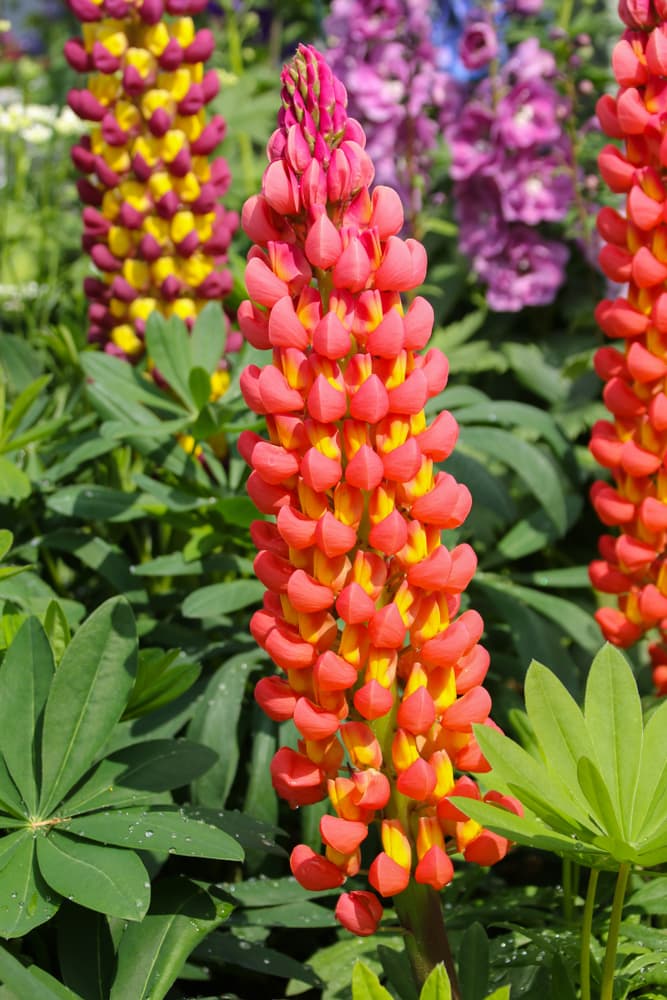
The name really says it all!
This variety grows up to 90cm tall, and boasts vigorous, flaming orange bells, making it a bold statement in any garden.
Flowering in summer and with gorgeous mid-bright green leaves, this plant is sure to make your garden pop.
‘Polar Princess’
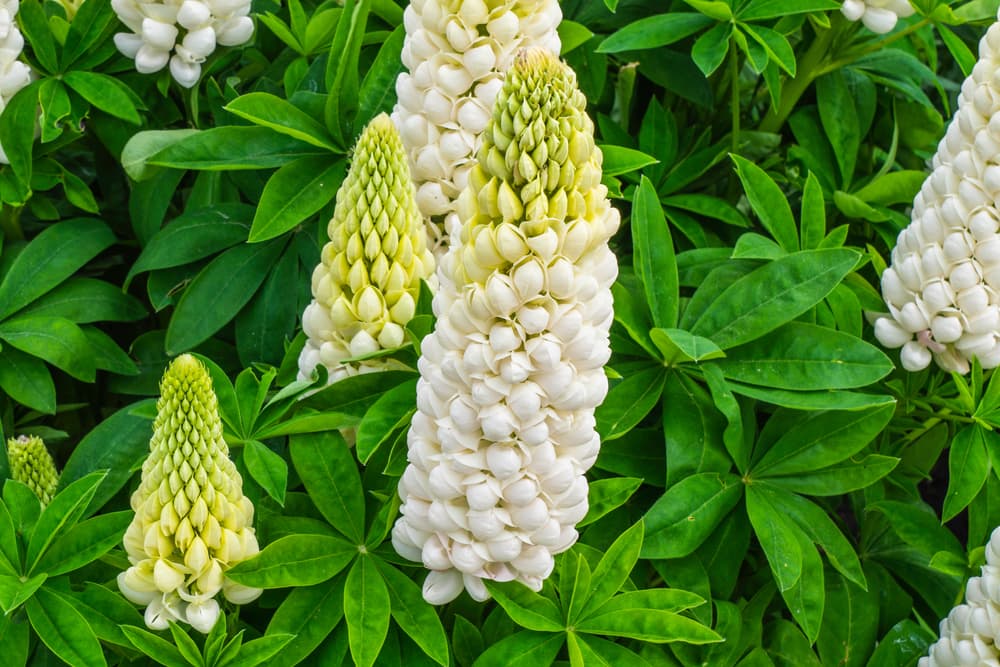
While this might sound more like a character from a Disney film than a garden plant, this variety is worth getting to know.
This radiant Lupin bears pure white, delicately scented flowers that bring a royal flourish to any flower bed.
Blooming late into summer this variety epitomises country cottage living.
‘Manhattan Lights’

Another early-season variety, this showy Lupin is adorned by sweetly scented purple and yellow flowers.
Gracing the garden from late spring to early summer, its gorgeous, decadent colours will be the envy of all your neighbours.
‘Dwarf Pink Fairy’ (Annual)
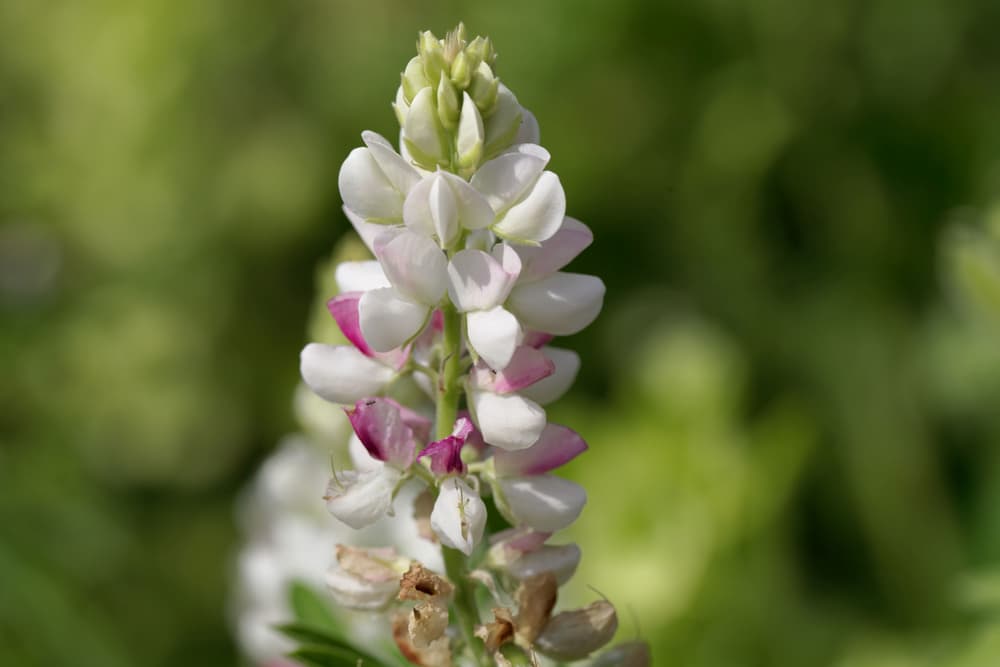
With its short stature, this annual Lupin is perfect for garden borders.
A soft pink, free-flowering variety that blooms all the way from early June to late August.
It has lovely green, bushy foliage and in the evenings its delightful, sweet-pea scent will linger in the air.
How To Grow Lupins
Now you’ve seen just how varied and beautiful Lupins can be, you’re probably keen to get them going in your garden.
This plant really is a vital ingredient for the quintessential British garden, so thankfully they are fairly easy to grow.
These hardy plants are also inexpensive and wonderfully reliable.
Here’s how to bring plant them out.
Soil Requirements
Lupins do not grow well in clay or chalky soil – they much prefer soil that is neutral to slightly acidic.
Moist, well-drained soil is recommended as the optimum, but they will tolerate most garden conditions.

Water-logged soil, however, is unsuitable and will most likely lead to rot.
Where To Grow
Lupins are sun worshipers, but they also enjoy cool soil.
Positioning newly planted flowers where they will receive full sun in the morning and shade in the afternoon will give them the best of both worlds, and help them to survive the summer heat.
Don’t plant in full shade: they won’t thrive.
This plant likes a bit of space to thrive and lends itself well to being grown in a garden border more than a narrow flower bed.
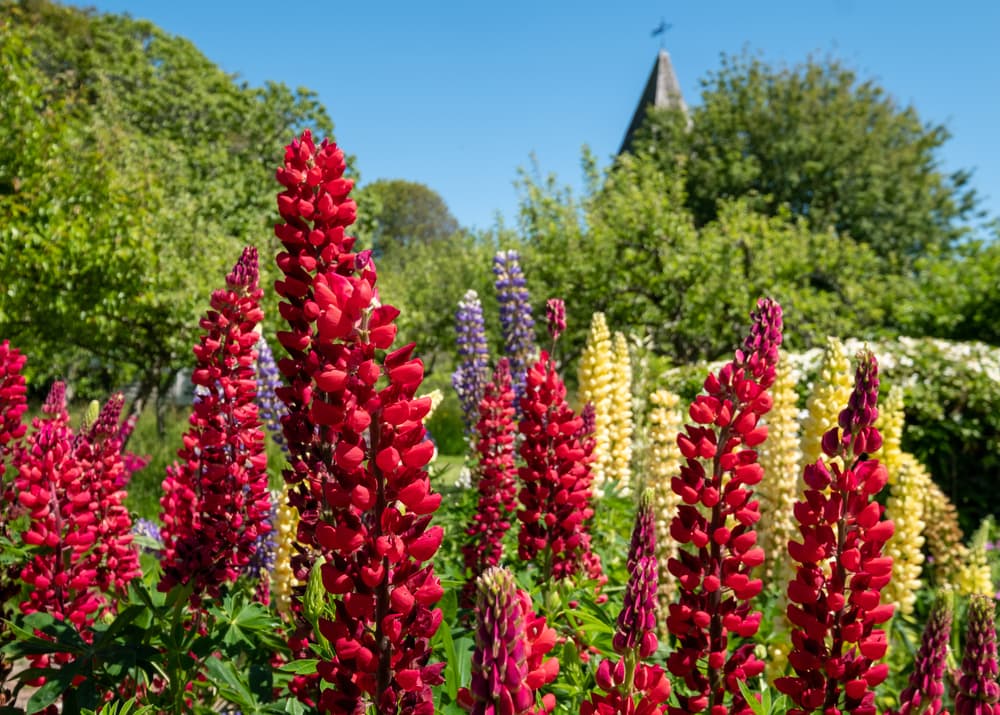
We don’t recommend planting Lupins in containers where possible, because this leads to less strong growth and can leave them more susceptible to aphids (more on these fellas later).
Growing From Seed
Lupins do not come true to seed, so if you plant seeds from a packet your lupins are likely to grow in a range of colours.
We advise soaking the seed the night before planting to encourage germination.
For the best chance of survival, sow in a seed tray from February to September, and keep this in a greenhouse or on a windowsill.
Leave them until they have four leaves, then plant out into the garden.
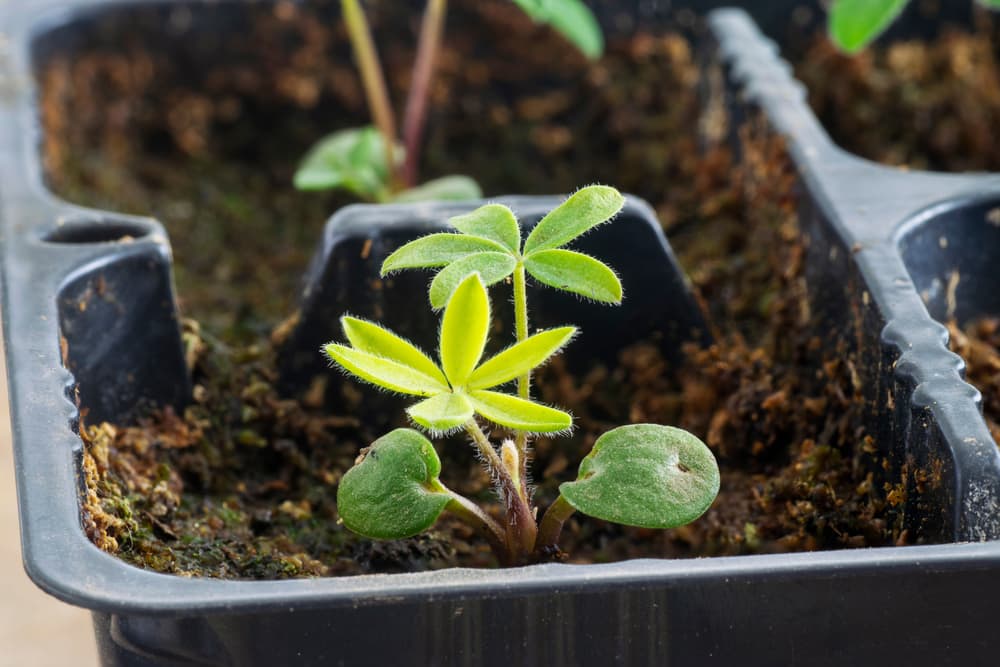
Once planted, water them once then leave them to find water on their own.
They prefer to be kept just below room temperature (15-20°C) and, when conditions are correct, will sprout about two weeks from planting.
Growing From Cuttings
Lupins grown from cuttings will be the same as their parent plants, so if you want a particular variety this is the only way to go.
If you’re taking a cutting, aim for a basal cutting (shoots of around 10cm growing near the base) taken in March or April.
This plant puts out a strong system of roots, so for the best prospects, it’s worth planting them out while they’re as young as possible.
They’re quite hardy and can withstand growing outside right away.
“For the best cutting compost, I add one-part perlite to two-parts fine peat-free compost (normally compost sweepings from my potting shed floor),” shares Dan Ori, a Master Horticulturist.
Planting
Although there is some leeway with when to plant (we mentioned February to September for sowing earlier), Lupins tend to do best when sown in early March, hardened off in late April and planted out in early May.
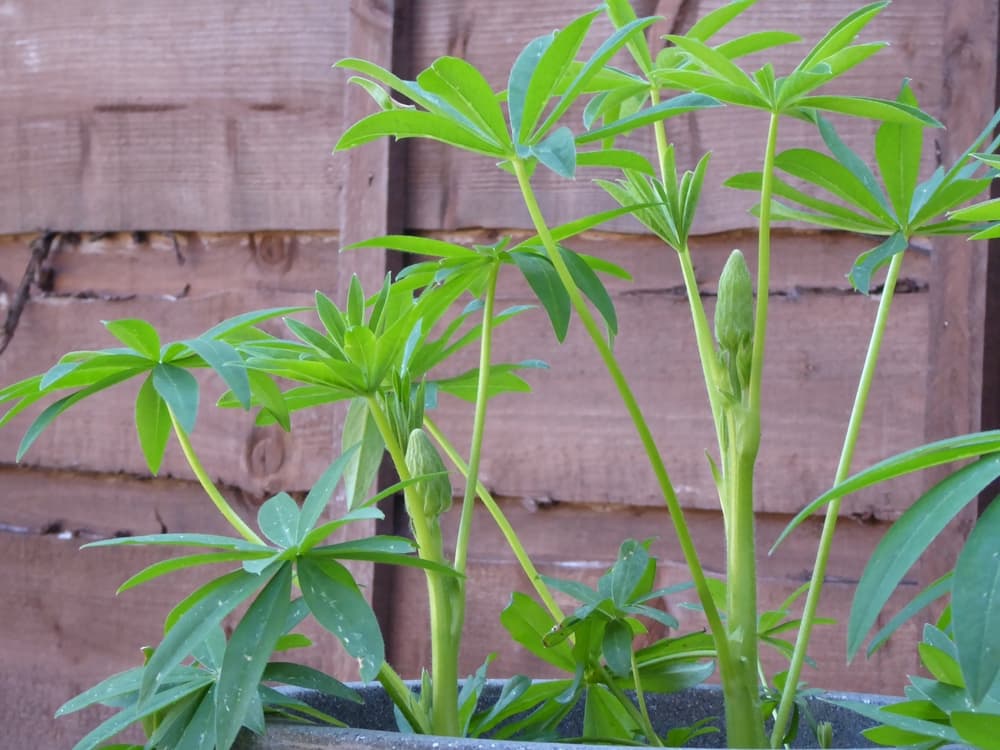
If you are harvesting seeds, this should be done in late summer, around early August.
Before sowing, seeds can be soaked for 24 hours in a small amount of water.
Though this isn’t necessary, it can help them to start growing more quickly.
Lupin Care
Lupins are diligent food-finders and don’t need any special feed.
In fact, adding high-nitrogen plant feed can make them grow too much, and increase the risk of attracting the aphids we mentioned earlier.
In winter, Lupin care is just a case of doing… nothing!
They will die back, then new shoots will appear in spring with no intervention required.

This really is a hardy and self-sufficient plant – perhaps one of the reasons it’s become such a staple in British gardens.
Pruning
This plant has a longer recovery time than some others, so we advise against chopping back too hard after flowering.
It is important to deadhead a well-flowering Lupin, however, as growing lots of seeds will drain energy and vitality from the parent plant.
Propagation
Most Lupins have a life cycle of six to ten years, depending on growing conditions.
So the time may very well come when you need to propagate your existing plants to ensure their continued presence in your garden.

Thankfully, this type of plant can grow successfully from cuttings (see above) and, if you have a delicate hand, through division.
Dividing
Division is a bit harder, and is not necessarily recommended unless you are a very experienced gardener.
Because of the structure of their roots, Lupins are prone to damage by division.
Instead, we recommend growing a new plant from seed or cutting is advised for the best likelihood of a healthy plant.
Common Problems
Lupins are fairly hardy, but there are a few things to keep your eyes peeled for.
Slugs & Snails
The perpetual bane of any gardener’s life, Lupins are not spared from the incessant attention of these garden pests.
A humane way to keep slugs and snails away is to create a garlic spray, and coat the leaves of your Lupin.
“I was very dubious about the use of garlic sprays to deter slugs and snails, but some convincing studies have shown it is effective if you apply it regularly,” says Dan.
“Knowing how regularly is a matter of trial and error, but those who have had success often apply a spray when they struggle to smell the garlic on the plant.”
Young plants are especially prone to getting munched, so remain especially vigilant for the first couple of years.
Giant Lupin Aphids
Another hungry pest, aphids are keen to get their teeth into your Lupins.
Once a colony takes hold of a plant they can cause it to wilt, they can be hard to dislodge.
This is what you’re looking for: small, white aphids that swarm the stem of the plant.

Gently rubbing leaves to remove them – or spraying with a stream of water that’s not too powerful – can do the trick, as can a variety of pesticides.
Personally we recommend the former.
Lupin Anthracnose
While slugs and aphids are creatures, anthracnose is a fungal disease that can wreak havoc with your Lupins.
It is not usually fatal but can cause a lot of damage from dieback.
Dead, brown areas, slimy orange spores, and coiled leaves are telltale symptoms of anthracnose.
Removing and destroying damaged leaves, and planting your Lupins so that air can flow freely around them are two ways of controlling and preventing this condition.
Brown Spot
This creatively named condition gives Lupins – you guessed it – brown spots.
It’s caused by spores in the soil your plant is growing in, so moving the plant is the best way to prevent further damage.

Once you’ve moved it, avoid planting any other Lupins in that spot for a few years – this will give the spores a chance to die off.
Lupins have been popular in British gardens for generations, and with good reason. They’re hardy, versatile, varied, and, almost universally, beautiful.
They’re easy to look after, resistant to weather, and although threatened by a few diseases and pests, many plants will live to maturity with little issue.
References
- 1Definition of lupine. (2023). In Merriam-Webster Dictionary. Retrieved March 21, 2023, from https://www.merriam-webster.com/dictionary/lupine
- 2Maron, J., & Connors, P. (1996). A native nitrogen-fixing shrub facilitates weed invasion. Oecologia, 105(3), 302–312. https://doi.org/10.1007/bf00328732
- 3Lupines (Genus Lupinus). (n.d.). iNaturalist. Retrieved March 21, 2023, from https://www.inaturalist.org/taxa/47121-Lupinus

